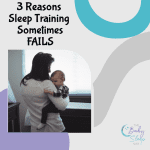
If your 6- or 7-month-old is waking up a lot at night, you might be wondering if you should start sleep training. And, if you are thinking about sleep training, you want to do it in the best way for your baby. This article will take you through the process of sleep training step-by-step based on my 15+ years as a pediatric sleep consultant.
In this article:
- What To Do Before You Start Sleep Training
- How Long Does Sleep Training 6-7 Month Olds Take?
- What Is the Best Sleep Training Method for Babies This Age?
- Step-By-Step Guide to Sleep Training 6-7-Month Olds
- More Resources for Sleep Training
What To Do Before You Start Sleep Training
Unfortunately, many parents will find themselves frustrated in the middle of the night and try to start sleep training impulsively. While I understand this frustration, it can work against you. Sure, if your baby goes to sleep within 20-30 minutes, you might be onto something. However, if your baby is still crying an hour later, most parents would give up and then feel like “it didn’t work.” In reality, there are a few key things you should do before you start sleep training so you can set your baby up for success:
Talk To Your Baby’s Healthcare Provider
Babies grow and change a lot in a short amount of time. Before you start sleep training, it is of the utmost importance that you make sure your baby is on track with growth and development. If your baby is having any trouble with weight gain, I recommend you sort that out first before you start sleep training. Please do NOT start sleep training if your baby is having trouble with growth or weight gain!
Address Safety
Before you start sleep training, be sure you have followed all of the safe sleep tips from the AAP to reduce the risk of SIDS.
Sleep Schedule Tips and Importance
I can’t tell you how many parents I’ve worked with over the years who have improved sleep simply by fixing their schedules! Schedules are so important because your baby has to be tired enough to sleep but not TOO tired. Some babies are more sensitive to overtiredness than others, of course. Overtired babies tend to wake more frequently and cry more before sleep.
Hungry babies can’t sleep, either. So, if you aren’t offering your baby enough milk and, possibly, solid foods, this can be disastrous for their sleep, too. Occasionally, I will see babies who are eating too much solid food (because they love it!) so they don’t drink enough milk during the day and wake up at night to drink milk. Milk is vitally important for growth and brain development for the first three years of life.
Lastly, you need to set your expectations about how many night feedings your baby might need at this age. Even if your friend’s baby is the same age, they might night-wean sooner than yours.
Here are a few articles for you to make sure you have the schedule right:
- 6-Month Old Sleep and Feeding Schedule
- 7-Month Old Sleep and Feeding Schedule
- Wake Windows By Age
- How Many Night Feedings By Age
- Solid Foods Feeding Schedule (Types of Food By Age)
Create a Bedtime Routine for both Nights and Naps
One final thing to do before you start sleep training is to create a bedtime routine that you can use at night and at nap time. I won’t harp on this because most people who are starting sleep training have already done this. Be sure to check out the link earlier in the paragraph if you have not or you have doubts about your current bedtime routine. Most of the time, this does not make or break sleep training.
How Long Does Sleep Training 6-7 Month Olds Take?
In my experience, the average time it takes for sleep training 6-7 month-olds is 2 weeks. Babies who are bed-sharing and moving to their crib sometimes take a bit longer (up to 30 days). Are there babies who “get it” in 3 days? Absolutely! And, I love getting those e-mails. But, to set realistic expectations, I often say to expect 2-3 weeks of work with the first 7-10 days being the most difficult.
Of course, I have been offering sleep training services for over 15 years and this means that I often work with more challenging babies. Many parents come to us when they’ve already tried sleep training on their own without success. So, my experience is influencing my data and hopefully, your baby will get it faster! I’ve seen many parents “fail” at sleep training only because they expect it to take 2-3 days and it takes ~2 weeks for their particular baby.
What Is the Best Sleep Training Method for Babies This Age?
The Baby Sleep Site exists largely in part with the fact that I didn’t like how many books contradicted each other and said their way was the only way. So, there isn’t a “best” method for sleep training all 6-7 month-olds. I strive to find the best sleep training method for YOUR baby!
In my experience, the fastest sleep training method at this age would be The Ferber Method. It is a mix of allowing your baby to cry but with the opportunity to soothe and reassure them. The typical method is to leave the room but you can use The Chair Method with soothing intervals if you prefer to stay in the room.
The one thing I do NOT like about the typical Ferber Method is that he recommends night-weaning at the same time. As you will see below with my step-by-step method, I recommend night-weaning last IF you have to. Many babies will drop unnecessary feedings on their own.
Is this the BEST method? It is NOT the best method if you don’t want to allow your baby to cry for long periods, especially unattended. Most of the parents who come to us are looking for a gentler sleep training method.
What About Gentle Sleep Training?
The sleep training method we recommend most often to our clients is Gentle Sleep Training. With gentle sleep training, you stay with your baby the entire time and it’s a very responsive method. Rather than soothe at set intervals, you respond to more or less intense crying using your instincts and knowledge of your baby. We can’t promise NO crying but we try to limit it as much as possible.
Gentle sleep training can take a bit longer (though not always!) but usually, parents and babies tolerate the process a bit easier. This makes it more likely you will be consistent and follow through which are both mandatory to see success.
Can/Should You Do Cry It Out?
Some people call The Ferber Method the same as “Cry It Out.” However, we define Cry It Out as a method of sleep training during which you leave the room and do not come back until it’s time to get up in the morning or it’s time for a feeding. We do NOT recommend Cry It Out very often for 6-7 month-olds because they have often started experiencing separation anxiety.
You may also be interested in…
Step-By-Step Guide to Sleep Training 6-7 Month Olds
Although I go through a lot more detail in my e-Book, The 3-Step System to Help Your Baby Sleep, here is a step-by-step guide to sleep training your 6-7-month old:
- Adjust the schedule, if necessary, and spend playtime in the crib or sleep space. We want their sleep space to be warm and welcoming. You will also want to use a consistent bedtime routine (day and night) and address their sleep environment, making any necessary changes before you start. (1-3 days.)
- Change just one or two variables to how you’re putting your baby to sleep. For example, if you are rocking your baby to sleep and then holding them for 20 minutes before you put them down, slow down and fade out the rocking completely. They will still be falling asleep in your arms, but no longer dependent on moving. We call this fading out baby sleep associations. (2-3 days.)
- Start putting your baby down drowsy, but awake after your bedtime routine, and start doing sleep training at bedtime ONLY. This means getting baby back to sleep as quickly as possible in the middle of the night and optimizing their naps even if it means helping them nap. This is because day and night sleep are handled by two different parts of the brain. We want to set them up for success at bedtime first! (2-3 days.)
- Continue sleep training at bedtime and then begin sleep training for night wakings that are NOT your predetermined feeding times. At this age, I recommend choosing one or two feeding times at least 3-4 hours apart but do NOT feed your baby back to sleep. Try to put them down after a feeding and continue sleep training. (2-3 days.)
- By now, your baby is likely sleeping for longer durations at night. Start sleep training for the first two naps of the day but don’t worry about the length, yet. Any late afternoon catnaps can continue to be assisted. (2-3 days.)
- Start lengthening naps by doing a “nap hour” where your baby will be in bed for one hour for the first two naps of the day. If they wake up before an hour is up, use the sleep training method you chose to extend it to one hour. (2-3 days.)
- Lastly, night-wean your baby by pushing the feeding time(s) 30-60 minutes later each night until you’ve arrived at the age-appropriate number of feedings. At this age, most formula-fed babies can be night-weaned completely while many breastfed babies will still have one feeding at night. Be sure to do what’s appropriate for YOUR baby! Babies with reflux, for example, may have night feedings for a longer period. Expectations are everything! (3-4 days.)
That’s it! You’re done! If you need a faster pace, you can combine steps. The primary goal of this gradual sleep training plan is to make it manageable for both you and the baby. However, you know your baby best and some babies are easier going than others.
If you are unsure if this plan is right for your baby and/or you need guidance and support while implementing the plan, be sure to contact us for a Personalized Sleep Plan written just for your family.
Sleep Training Breastfed Babies
I get the question a lot about whether sleep training breastfed babies is different. We work with breastfeeding moms every single day! You can be successful with sleep training AND maintaining your breastfeeding relationship. When we work directly with breastfeeding moms, we do prioritize breastfeeding OVER sleep, however. That means sleep may or may not be “perfect” but your milk supply comes first. Be sure to check out our Baby Sleep and Breastfeeding Series for tips on sleep training while breastfeeding.
Sleep Training Naps: Is It Different?
Sleep training for naps isn’t very different than nighttime sleep training but there are a few things to note:
- Day and Night sleep are handled by two different parts of the brain according to Dr. Marc Weissbluth, author of Healthy Sleep Habits, Happy Child. Therefore, we can often focus on one at a time. This is my recommendation for most families. On the other hand, this occasionally means the sleep training methods are different for each.
- We typically limit sleep training sessions at nap time to just one hour for 6-7 month olds. If your baby hasn’t fallen asleep, get them up for a 1-hour break and then try again.
- The schedule often gets off-track during sleep training but it will get back on track within a few days, usually. Start each day with the intention of following your schedule from Step 1 above. However, consistency wins over the schedule (if you have to choose). Try to adhere to wake windows as much as possible but within reason.
You may also be interested in…
More Resources for Sleep Training
This article can only scratch the surface of sleep training your 6 or 7-month-old. We have over 500 articles on this website dedicated to better sleep for your family. Here are a few more resources you may be interested in:
- 3 Signs It Might Be Time for Night Weaning
- Sleep Training Baby: The Ultimate Guide
- Baby Sleep Regressions
- Sample Schedules for All Ages
- 5 Ways to Help Your Baby Sleep Through the Night – Download this free e-Book and join our mailing list for free articles sent right to your mailbox!








